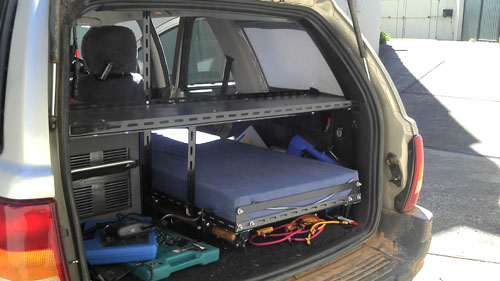Camping (as in "accommodation")
Whilst you can make excursions into remote areas from the comfort of motels and caravan parks, that is not what this section is about. The context here is that you will be camping remotely for extended periods of at least 1 to 2 weeks, possibly more. However, we are not talking about living off the land or semi-permanent base camps.
What kind of accommodation?
Most prospectors will tow a caravan or camper trailer of some description when going outback. Obviously, this provides a more luxurious camping lifestyle than living out of a tent, swaggie or your car. The trade-off is mobility and accessibility to more remote areas. Security is also a consideration. The only 'correctness' of your choice is determined by how well your trade-offs match your aspirations.
When planning an outback trip it is best to ensure that all fellow prospectors have similar capabilities. For example, everyone should be able to camp out for a minimum of X weeks and move camp in a minimum of X hours, etc. If you can be ready to move camps in minutes wheras your buddies take hours, you may find that an issue.
Food, water and fuel
Obviously your food supply must match or exceed the duration your intended stay. Generally a refrigerator is a must, however, it is possible to get by without; although health issues may be a concern over extended periods.
The main factor limiting how long you can camp remotely is likely to be water. Based on 5 litres per day, 2 weeks will require 70 litres. That excludes bathing water and any safety factor. If you allow 10 litres for bathing (after the first week) and 4 days of emergency supply (for example, in the event that you are 'rained-in'), you are then looking at 100 litres. Additionally, if the weather is warm to hot, daily requirements can increase dramatically. Also, for safty reasons you should have your emergency water stored in a seperate container, such that you do not lose everything should your main supply develop a leak.
In order to reduce your water consumption to 5 litres per day:
- Reuse water where possible (save vegetable washing water for dish washing, etc).
- Use disposable paper plates to save on washing.
- Only trickle water out of taps.
- Turn off taps whenever the water is not actually being used.
- Use 'baby wipes' for personal hygiene. Best to experiment beforehand to find a brand you are not adverse to. I like the Coles brand Ultra Sensitive Baby Wipes or Kleenex Cottonelle Flushable Fresh Wipes.
- Skip the bath and only wash your hair, if you must. Better to keep it short, wear a hat and don't touch it. If you do wash your hair then also use a conditioner to help reduce any itchies.
- Drink more beer!
Sure, you can carry more water but then after two weeks bush, going into town for supplies, a bath and laundry is a great 'day off'. It also gives you a chance to catch up on your email, pay your bills and call home. Also remember to cart your garbage back to town with recyclables separated if applicable.
Fuel can also cramp your style. Especially when 4-wheel driving and towing, fuel consumption will be relatively high. Also if you are 'exploring' an area, that means more driving. How much extra you require is highly variable but a good starting point is to carry about the same as your nominal fuel tank capacity. Plus always carry an emergency supply that you plan to never use (until you get home).
Refrigerator Power
If you're running a refrigerator in your car then electrical power becomes an issue; otherwise all power requirements can be met off the car's battery for charging your detector, phone, etc. You will however need to run your engine every couple of days to keep your car battery charged.
The nominal approach for powering a refrigerator in the car, is off a second battery connected via a dual-battery isolator (see note below). Unfortunately this requires running the car for long enough each day to keep the second battery topped up. For a deep cycle battery, recharging can take quite a while. This is okay if you're travelling the highway but this will likely be a problem when detecting in one spot over several days. A better approach for outback prospectors is to use a roof mounted solar panel.
Note that many newer vehicles use ECU Controlled or Temperature Controlled, Variable Voltage Alternators that are not suitable for charging a secondary battery via dual-battery isolators (after the starter battery has been charged, voltage from the alternator will be reduced). Instead you will need to use a DC-DC battery charger (reference). Both RedArc and CTek manufacture these and have models that also accept solar panel input and are designed to replace your solar controller. Refer RedArc BCDC1225-LV (requires an external change-over relay to switch between alternator and solar inputs; ref Fig 2.2 Instruction Manual) and CTek D250S DUAL (manages both power inputs automatically, however, turns off if supply voltage drops below 12.8 volts for 10 seconds; ref Pg 12 Instruction Manual). You will need to determine what kind of alternator (ECU Controlled or Temperature Controlled you have, but more specifically, the minimum voltage it will generate; best to check with a supplier, alternatively drive around with a voltmeter attached) you have in order to determine which device to use.
If the refrigerator is a 3-way powered type and in the towed accommodation then the refrigerator will typically be run off gas. You just need to keep your gas bottles topped up; but you will likely also need to keep your accommodation's lighting and accessories battery topped up.
Alternatively you can run a car-type refrigerator, in your towed accommodation, with a second battery and keep it topped up with a generator or solar panel. Obviously solar panels are more convenient than generators, although security then becomes more of an issue when the camp is left unattended during the day. Additionally a backup charging mechanism is required for days when the weather is uncooperative. Nominally you will use your car's alternator for this contingency.
As an example, my 32 litre Engel car fridge/freezer, located in my car, is rated to consume 20 Amp Hours per day. I have that coupled to a 110 Amp Hour hybrid/marine battery (note that an AGM battery is preferable) hooked up to a dual-battery isolator system, that, in addition to the standard override button, I can manually engage/disengage, and a 120 watt solar panel mounted on my car's roof. I usually have the dual-battery isolator disengaged and only engage when solar power is low (and second battery requires additional charging) or in the event my car's starting battery dies (and needs a starting boost from the second battery). This setup also provides a contingency in the event that my solar controller fails (as it did when I was in the bush).
Keeping the two dis-similar batteries disconnected (by disengaging the dual-battery isolator) prevents any tendency for one to discharge the other.
Alternatively two similar hybrid/marine (starting/deep-cycle) batteries could have been permanently engaged, via the dual-battery isolator, without ill-effects (with the dual-battery isolator used to preserve starting power in the primary battery).
Picture below shows my 120 watt solar panel mounted on my car. I also have 2 cross bars on the roof used to mount a carry basket for carrying an extra spare wheel. Also running along side on the left you can just see a tent pole that will extend to the left UHF antenna. This is used to attach a tarpaulin for use during inclement weather.
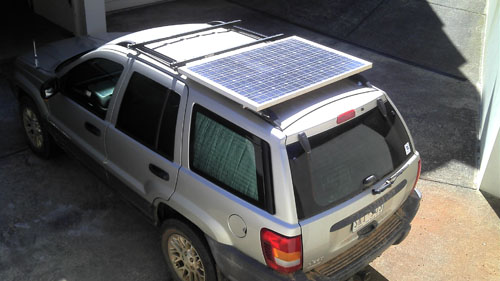
Camping out of your car
There are many way to camp out of your car:
- Tent - on the ground. This reduces mobility and can be yucky if packing up in the wet (and mud). You will also want to keep your mattress off the ground to keep the morning chills out of your bones (with a camping stretcher?).
- Tent - on your car roof. Good but limits what else can be mounted on your car roof, eg. solar panel, spare wheel, etc.
- Swaggie - More mobile than an on-ground tent but you may want to put it on a stretcher to keep it off the ground (to avoid morning chills). If using a stretcher you will want one that is slightly smaller than the swag so any rain will run off.
- In-car - highly mobile and convenient (bed is always available) but consumes available space in your car. If coupled with an in-car refrigerator, as is likely, available space becomes an even greater issue. This option also best protects you from the environment and morning chills.
- Slide-on or fixed camper for a cab-tray or utility type vehicle. There are many configurations to pick from as well as build your own. Most are based on tradies tool-boxes although caravan-style slide-ons are also avaliable. Try Googleing for "slide on camper".
If you can manage the available space in your car, then in-car camping provides the greatest mobility, convenience and comfort. If in-car space is an issue then a slide-on or fixed camper will provide more space; but will obviously require a utility type vehicle.
In-car camping pictures
100 litre water tank replaces front passenger seat. At bottom left corner of the tank can be seen a caravan water pump (within plastic box under the hoses) and outlet that can be used for pumping water into or out of the tank, or bypassing the tank altogether. Green tap at centre bottom is used for drawing water.
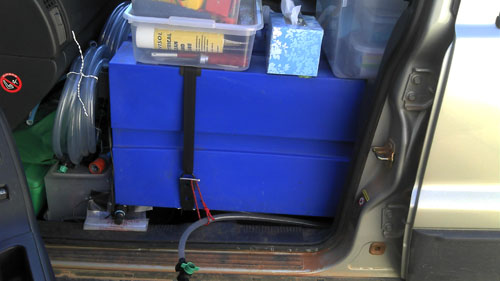
Picture below shows rear of water tank and entry to accommodation. On right hand side is the second battery. The refrigerator can be seen just right of the battery. Also note tent (antenna) poles and other long items under the mattress. All of the rear seats have been removed. This provides space for all 4x4 recovery gear.
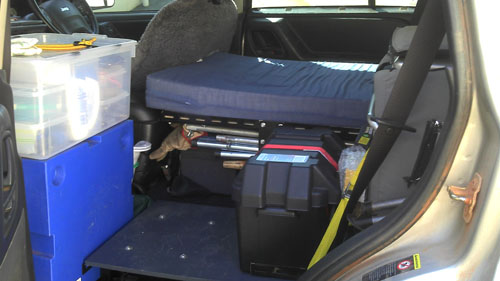
A front to rear view. Solar controller plus a spare (wrapped in plastic) can be seen just above the battery.
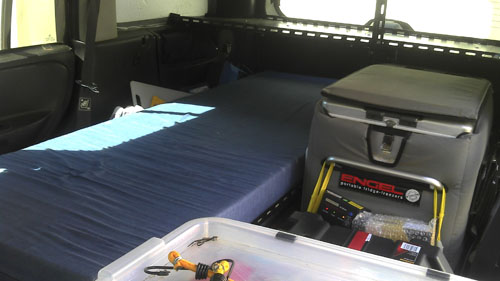
Rear view, showing back of refrigerator and shelfing - space is at a premium! When fully loaded some stuff (like jerry cans) will be sleeping outside! Also planning to add a bit more shelfing above mattress.
